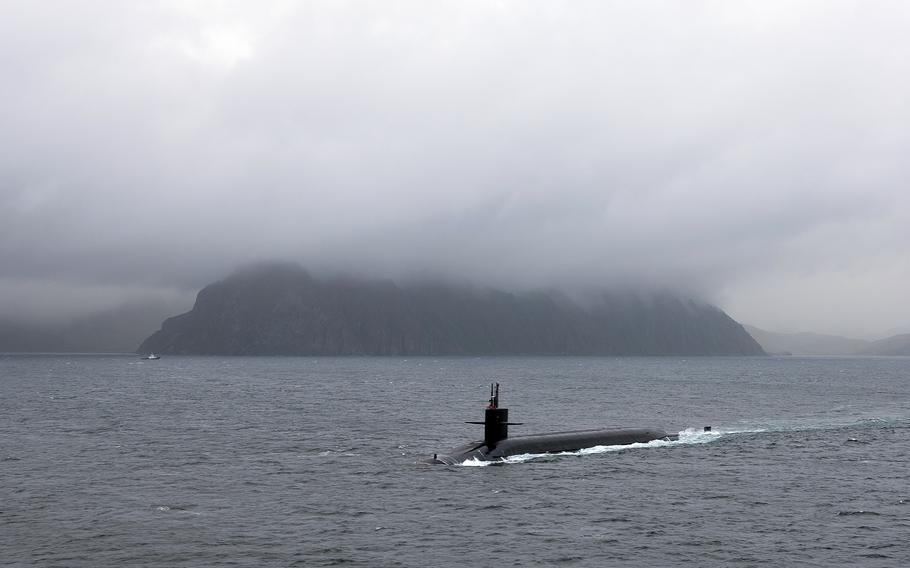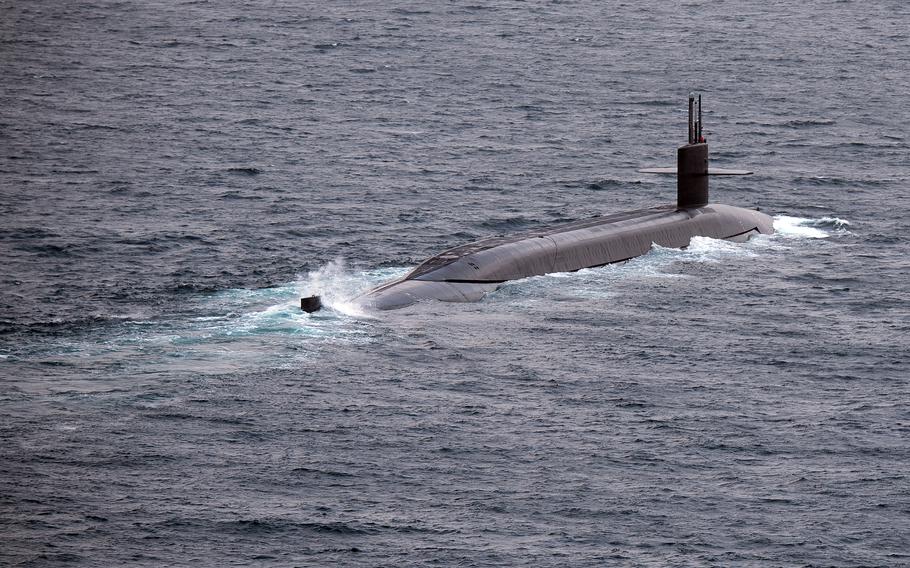
The ballistic missile submarine USS Kentucky departs Broad Bay in Dutch Harbor, Alaska, Aug. 24, 2017. (Shaun Griffin/U.S. Navy)
CAMP HUMPHREYS, South Korea — A U.S. Navy nuclear ballistic missile submarine sailed into South Korea’s largest port on Tuesday for the first time in 42 years.
The USS Kentucky — one of 14 Ohio-class nuclear-powered ballistic missile submarines in the fleet — arrived at Busan in another display of Washington’s commitment to defend Seoul, according to a news release from South Korea’s Ministry of National Defense on Tuesday.
The Kentucky’s arrival is an example of the U.S. military deterrence and shows the “overwhelming capabilities and readiness” of the U.S.-South Korean alliance against North Korea, National Defense Minister Lee Jong-sup said in the release.
The Kentucky was commissioned in 1991 and is homeported in Naval Submarine Base Bangor, Wash.
U.S. ballistic missile submarines make extended sea patrols and can carry up to 20 Trident II D-5 ballistic missiles that have a range of 4,000 miles, according to the Navy’s website.
Trident II D-5 missiles may carry W76 and W88 nuclear warheads, the latter capable of a 475-kiloton blast, according to the U.S. Department of Energy and the Center for Strategic and International Studies.
Neither U.S. Forces Korea nor the Ministry of National Defense immediately responded to email and phone queries Tuesday about whether the Kentucky is armed with nuclear weapons.
A visit by a ballistic missile submarine capable of launching nuclear weapons provides a “reassurance effect” for Seoul but the U.S. should not solely rely on flexing its military might against North Korea, according to Jenny Town, a senior fellow at the Stimson Center and the director of 38 North, an organization of analysts who study Pyongyang’s weapons programs.
“This kind of move is likely to have a positive impact on US-[South Korea] relations, but will also, in the process, further agitate relations with North Korea,” she said in an email Saturday. "Relying on deterrence messaging alone has us locked into an escalation spiral with North Korea, as it tends to respond to these kinds of demonstrations, with further missile launches and its own missile deployment drills to show it won’t be intimidated.”

The ballistic missile submarine USS Kentucky departs Broad Bay in Dutch Harbor, Alaska, Aug. 24, 2017. (Shaun Griffin/U.S. Navy)
The Kentucky’s visit is part of an agreement between President Joe Biden and South Korean President Yoon Suk Yeol to "further enhance the regular visibility of strategic assets to the Korean Peninsula," according to a joint statement made during Yoon's state visit to the White House on April 26.
During that visit, Biden and Yoon agreed on more economic, technological and military cooperation as part of the 70th anniversary of the alliance between their countries.
The last such visit from a U.S. ballistic missile submarine was in 1981, retired South Korean navy Col. Moon Keun Sik told Stars and Stripes by phone Monday.
The nuclear-powered USS Michigan, a guided-missile submarine, sailed into Busan one month before the Kentucky. The Michigan carried out joint special warfare exercises with South Korean forces to “[respond] to North Korea’s advancing threats,” the Ministry of National Defense said in a statement June 16.
North Korea’s state-run Korean Central News Agency in July cautioned in numerous reports against the scheduled visit by a U.S. ballistic missile submarine.
North Korea’s Ministry of Defense on July 10 described the planned visit as “nuclear blackmail” and warned it may “incite the worst crisis of nuclear conflict,” according to KCNA.
The U.S. and the U.N. Security Council would be to blame if nuclear war breaks out, according to Kim Yo Jong, a senior Workers’ Party official and sister of North Korean leader Kim Jong Un.
“Such military provocations of the U.S. are the most direct threat to the security of not only [North Korea] but also all other … countries [in northeast Asia],” she said in remarks published by KCNA on Saturday.
North Korea has fired 15 ballistic missiles in 11 separate days of testing so far this year. The communist regime last launched the Hwasong-18, a solid-fueled intercontinental ballistic missile, on Wednesday.
It flew for 74 minutes — a record for a North Korean missile — before landing in the sea about 155 miles west of Japan’s Okushiri Island.
Further missile tests from North Korea “would not be out of the realm of possibility” following the U.S. submarine visit, according to Dave Schmerler, a senior research associate at the James Martin Center for Nonproliferation Studies at the Middlebury Institute of International Studies.
“This, in combination with the North Korean complaints about a [U.S.] spy plane off their eastern coast, will likely result in more signaling from North Korea, which will likely include more missile tests,” he said in an email Thursday.